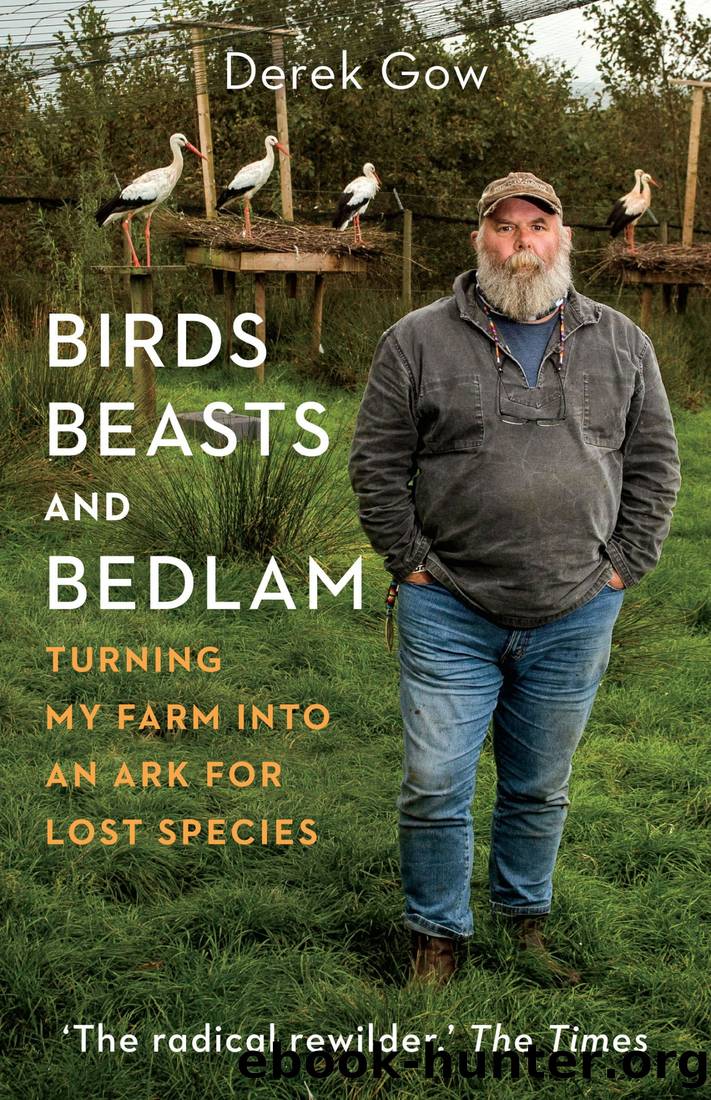Birds, Beasts and Bedlam: Turning My Farm Into an Ark for Lost Species by Derek Gow

Author:Derek Gow [Gow, Derek]
Language: eng
Format: epub
ISBN: 9781645021339
Google: fR7MzgEACAAJ
Publisher: Chelsea Green
Published: 2022-09-15T20:38:27+00:00
Heinz argued there were no throwbacks in appearance to the parent breeds from the race he had made and that his calves were âas alike as slices of bread from one loaf.â This propaganda is quite simply untrue. Heck cattle are coloured like aurochs and look very similar as long as you put all the brick red ones, the black and whites, and any hairy coated highland reversions that donât, into burgers. Years ago, a chum of mine, the elegant, silver-haired Dr Jonathan Spencer was at a conference in Europe. Having hit the beer hard with entertaining comrades the night before, he was snoozing through the presentations being given the following morning when, all of a sudden, the Dutch speaker flicked a slide up which showed a poster of a Heck bull tossing a swastika with its horns. Turning to a colleague who spoke the lingo, he asked her for an explanation.
âAhhh,â she said. âItâs a Dutch resistance poster from World War II and it says: âHeck cattle: another Nazi shamâ.â
That aurochs were once found in Britain is, without doubt, the case. Their remains are well distributed throughout the island and one skull that was unearthed from the depths of Burwell Fen in Cambridgeshire in Victorian times, and which now reclines in a glass case in the wrought cast-iron galleries of the Wisbech and Fenland Museum, has the remains of the flint axe which killed it embedded in its forehead.
It is unclear exactly when they became extinct but a partial skeleton found in blue clays of Porlock Bay on the North Devon coast by Nigel Hester from the National Trust in 1996 was radio carbon dated to the Bronze Age between 1738â1450 BCE and may have been from one of the last. Like Nigel himself, now grey moustached and retired, it was an old and arthritic male well past its prime.
In the nature reserve of the Oostvaardersplassen in the Netherlands, behavioural studies of the large free-ranging herd of Heck cattle which live there show that big bulls commonly move away from the breeding herds because, although large, they lack the stamina required to pursue the swift running cows. Alone or sometimes with another similar companion, they can live out a bachelor life in its reed beds for many years. On occasion, when the wind blows in from the North Sea at the end of a breeding season, bringing early snows and freezing temperatures in its wake and the herd bulls that are younger have burnt out their body fats and die, their absence can allow the solitary old bulls one last breeding fling. They fight again when they should not and in doing so can incur fatal or crippling injuries. An examination of Nigelâs bull showed that it had suffered a series of injuries when alive. A fracture to its pelvis that could have caused it to limp and two broken ribs which had healed. There were signs of infection around a third rib which may have hastened its passing.
Download
This site does not store any files on its server. We only index and link to content provided by other sites. Please contact the content providers to delete copyright contents if any and email us, we'll remove relevant links or contents immediately.
The Lonely City by Olivia Laing(4768)
Animal Frequency by Melissa Alvarez(4424)
All Creatures Great and Small by James Herriot(4267)
Walking by Henry David Thoreau(3921)
Exit West by Mohsin Hamid(3791)
Origin Story: A Big History of Everything by David Christian(3665)
COSMOS by Carl Sagan(3584)
How to Read Water: Clues and Patterns from Puddles to the Sea (Natural Navigation) by Tristan Gooley(3430)
Hedgerow by John Wright(3313)
How to Read Nature by Tristan Gooley(3289)
The Inner Life of Animals by Peter Wohlleben(3282)
How to Do Nothing by Jenny Odell(3263)
Project Animal Farm: An Accidental Journey into the Secret World of Farming and the Truth About Our Food by Sonia Faruqi(3189)
Origin Story by David Christian(3169)
Water by Ian Miller(3154)
A Forest Journey by John Perlin(3042)
The Plant Messiah by Carlos Magdalena(2900)
A Wilder Time by William E. Glassley(2833)
Forests: A Very Short Introduction by Jaboury Ghazoul(2814)
